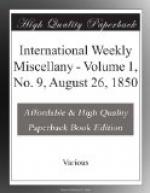the country to prove the imposture of his pretensions.
This piece of barbarism produced an effect the reverse
of what they expected. The venerable face of the
Imam, the attitude in which he had expired, with one
hand pointed as if to heaven, was more impressive
to those who crowded round the body than his fearless
enthusiasm had been,—and thousands who till
then had held aloof, now joined his followers in venerating
him as a prophet. Of this first warrior-priest
of Daghestan, Schamyl was the favorite disciple and
the most trusted soldier. Kasi-Mullah was not
killed until Schamyl had already fallen as it seemed,
under several deadly wounds:—his reappearance
after this bloody scene was but the first of many
similar escapes, the report of which sounds like a
fable. He did not, however, at once succeed to
the dignity of Imam: the office was usurped for
more than a year by Hamsad Beg (Bey), whose rapacious
and savage treatment of some of the princely families
of Daghestan nearly caused a fatal reaction against
the new sect, and the destruction of its main support,
the Murids. Hamsad Beg performed no action of
consequence against the Russians; but expended his
rage upon the natives allied with them, or reluctant
to obey his mandates. He was assassinated in
1834, by some kinsmen of a princely house whose territories
he had usurped after a massacre of its princes.
In the affray which took place on this occasion, there
perished with him many of the fanatic Murids, who
had become odious as instruments of the cruelties
of their Imam. On his death, Schamyl was raised
to the dignity,—but it was some time before
the mischief done by his predecessor was so far repaired
as to allow him to act with energy as the prophet
of the new doctrine. One of the ill effects of
Hamsad Beg’s iniquities had been the defection
to the Russians of n notable partisan—Hadjii
Murad—for many years a fatal thorn in the
side of the independent party.[6] This and other difficulties,
among which was the unpopularity of the Murids under
Hamsad Beg, were removed by new alliances and precautions,
while all that eloquence and skill could perform was
applied to restore the credit of the religious system,
before Schamyl could hazard a direct attack of the
Russian enemy, who meanwhile had taken advantage of
the delay and disunion to gain ground in many parts
of Daghestan. From the year 1839, however, the
tide rapidly turned; and the result, from that date
until the period at which the account closes (1845)—when
Woronzow was appointed to command in the Caucasus,
with nearly unlimited powers,—has been,
that the Russians, in spite of tremendous sacrifices,
were constantly losing ground and influence, while
Schamyl gained both in equal proportion. The
details of the campaigns during this interval are
highly interesting; and we regret that conditions of
space forbid us to translate some of the exciting
episodes recorded by Herr Bodenstedt. We may,
however, extract the following account of the Caucasian
hero,—whose portrait, we believe, has never
before been so fully exhibited to European readers;—




